Results
-
£139.99
Cobra - Jan Bosveld
Shortly after the Second World War, a combative movement of Danish, Belgian and Dutch artists chose the cobra snake - extremely dangerous yet considered sacred - as a symbol of their resistance to strict guideliness of form. The name "Cobra" also happens to contain the first letters of the cities Copenhagen, Brussels ans Amsterdam, from where most of the movement's members came. The Cobra movement, which existed from November 1948 until November 1951, can with some justicication be called the last major avant-garde movement of the 20th century.The source of inspiration for the composition Cobra comes from four paintings: "Obhobning" by the Dane Egill Jacobsen; "La jeune fille et lamort" by the Belgian Pierre Alechinsky; "Orgeldraaier" and "Le rythme joyeux de la ville" by the Dutch artists Karel Appel and Corneille. Obhobning means "pile-up", which is represented musically in the first part by a melodic and harmonic pilling up of perfect fourth's. The first part is also characterized by a rhythmic feeling, which the painting gives through its use of numerous black stripes. In the painting La jeune fille et la mort, Pierre Alechinsky places a young girl opposite Death. The second part features the constantly pulsating motion of live while a creeping, dark, melodic line develops. The tension between life and death is tangible as a battle reveals itself. In part three, one hears the Orgeldraaier by Karel Appel, as cheerful and playful as an organ grinder's music. The painting Le rythme joyeux de la ville by Corneille is busy and extremely dynamic, a perfect source of inspiration for a powerful, rhythmic ending to this composition.
Estimated dispatch 7-14 working days
-
£149.99
Bridge Between Nations - Jacob de Haan
This work builds a musical bridge between the nations of the European Union. In this composition each country is represented by a fragment of its national anthem. The listener will continually be surprised by the creative way the national anthems are presented. The national anthems of the nations that have become part of the EU in 2004 have already been included in this piece. Because the fragments follow each other and complement each other in a logical way, this work does not sound like a regular medley but rather like a varied concert work with interesting elements of folklore. For most of the national anthems Jacob de Haan has chosen a minor key, which gives this work an extraemotional, sometimes melancholic overtone.
Estimated dispatch 7-14 working days
-
 £204.99
£204.99So Nata Per Te - Ferrer Ferran
So Nata Per Te -- or Naci para ti in Spanish -- translates as "I was born for you". This symphonic suite is inspired by Pepe Domingo, a great music enthusiast and lover of life who wanted to commemorate his long and happy marriage to his dear wife, Concha. He commissioned Ferrar Ferran to set to music the great bond of their partnership: the couple will be able to close their eyes and relive through the music their most precious memories one by one.So Nata Per Te is a suite of many contrasts. Its contemporary, modern flavours are entertaining while the colourful variations are exciting and fascinating. Audience members may recall happy memories in their ownlives listening to the delightful, famous tunes that appear throughout the work and, although somewhat different from the originals, they are easily recognisable.Ferrer Ferran dedicated this work to Pepe Domingo and his wife Concha not only for their great enthusiasm and passion for music, but also for their mutual love. So Nata Per Te was premiered on 27 February 2010 at the Auditorio Florida of Paiporta (Spain) by the Banda Primitiva de Paiporta, conducted by the composer.
Estimated dispatch 7-14 working days
-
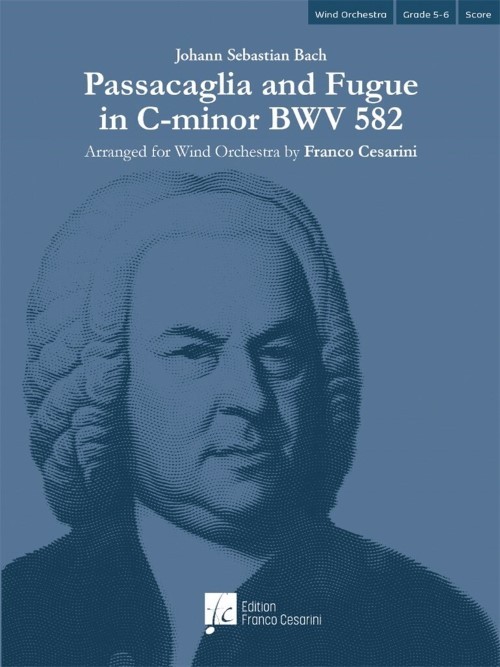 £167.00
£167.00Passacaglia and Fugue in C minor BWV 852 (Concert Band - Score and Parts) - Bach, Johann Sebastian - Cesarini, Franco
The Passacaglia is a set of instrumental variations based on an ostinato bass. Bach's Passacaglia and Fugue in C-minor for organ represents the pinnacle of what had been achieved in this compositional form at that time. In Franco Cesarini's arrangement for large wind orchestra, the particularly careful interpretation of the original piece enables him to exploit all the sound colors at his disposal, and in this sumptuous guise Bach's work also takes on a grandiose dimension, albeit tinged with late-Romanticism. The exposition of the beautiful theme begins in the bass part, immediately creating a solemn and serious atmosphere which is accentuated by the intensely pathetic character of the first variations. Up to the tenth variation it remains confined to the bass, but in subsequent ones it also passes to the soprano and alto register. The integrity of the theme is also embellished with elegant arpeggios, in whose lower and higher extensions the theme can be distinguished. Towards the end it returns to the bass in an impressive thickening of the polyphonic texture that swiftly re-establishes the key of C-minor. The "Thema fugatum" which follows immediately does not constitute a Fugue in its own right, rather it is nothing but the twenty-first and most extensive variation of the Passacaglia. This time Bach uses only the first half of the theme, superimposing a rhythmic countersubject that considerably enlivens the entire development of the composition. The polyphonic discourse becomes increasingly dense, until the building tension peaks in a powerful "Neapolitan sixth" chord, followed by a sudden pause. This culminating moment then leads to the coda and final cadence on a bright C-major chord. Duration: 12.45
Estimated dispatch 7-14 working days
-
 £50.50
£50.50Megawatt Rock (Concert Band - Score and Parts) - Sheldon, Robert
Robert Sheldon's Megawatt Rock will light up your next concert. This high-energy rock-style piece with its rhythmic drive and power chords is sure to amp up the spirit in the performance level of the students. Using only the first seven notes that most beginning band students learn, it is written in Mixolydian mode, with the key signature including the added flat. The rhythms, dynamics, articulation, key, and style provide electrifying teachable moments that occur throughout the piece at no extra charge! Duration: 2.00
Estimated dispatch 7-14 working days
-
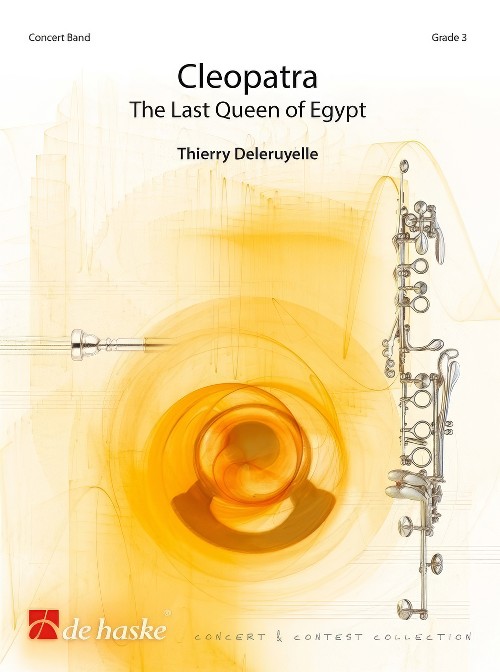 £134.99
£134.99Cleopatra (Concert Band - Score and Parts) - Deleruyelle, Thierry
The Last Queen of Egypt. Queen Cleopatra ruled Egypt for over 20 years. She is one of antiquity's best-known women, in particular because of her relationships with Julius Caesar and, above all, Mark-Anthony, but also because the cause of her death remains a mystery. The work is split into three parts and performed without breaks. The first section begins with a bright introduction representing Mark-Anthony. Dynamic in nature and reminiscent of military music, this characterises the Roman general. But soon after, another theme emerges, softer and more melodic, symbolising Cleopatra's femininity. The two characters then combine on a faster tempo. The middle section of the work depicts the love that Mark-Anthony and Cleopatra feel for each other. This passionate relationship lasted ten years and produced three children. This is expressed by a warm and intense theme, just like the beauty of the Egyptian queen. The third and last section opens in a determined and military mood. Mark-Anthony and Cleopatra were often apart, the Roman general was often away on a campaign. They met up in Alexandria to celebrate their triumph. But, as the targets of the jealousy and ambition of Octavius, Julius Caesar's son, the lovers are trapped and await the inevitable conquest of Egypt by the Romans. When Mark-Anthony heard the false news that Cleopatra had committed suicide, he ended his own life. The Queen of Egypt, for her part, was imprisoned shortly afterwards. The two lovers remain one of History's most famous couples. This piece was commissioned by the Wind Orchestra of the town of Antony, near Paris, directed by Philippe Rossignol, to mark its 90th anniversary. Duration: 10.00
Estimated dispatch 7-14 working days
-
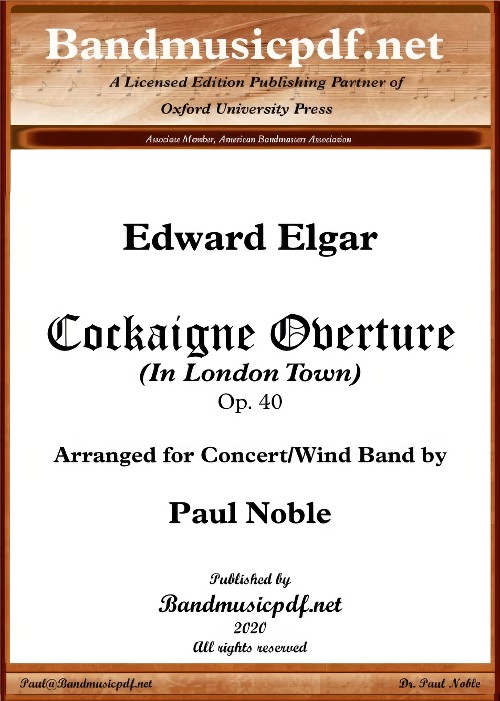 £150.00
£150.00Cockaigne Overture (In London Town) (Concert Band - Score and Parts) - Elgar, Edward - Noble, Paul
Cockaigne Overture was composed when Edward Elgar received a commission from the Royal Philharmonic Society, and he reported that the new piece was "cheerful and Londony, 'stout and steaky'...honest, healthy, humorous and strong, but not vulgar." The first performance was in the Queen's Hall, London, on 20 June 1901, conducted by the composer. He dedicated the work to his "many friends, the members of British orchestras." The music was an immediate success and became one of Elgar's most popular works. In its 15 minutes or so, the overture gives a lively and colourful musical portrait of Edwardian London. 'Cockaigne' was a term used by moralists at that time as a metaphor for gluttony and drunkenness, while Britain adopted the name humorously for London, and from it we get the Cockney. Cockaigne or Cockayne /ka' kein/, the word origin tracing back to the 13th century, is a land of plenty in medieval myth, an imaginary place of extreme luxury and ease where physical comforts and pleasures are always immediately at hand and where the harshness of medieval peasant life does not exist. The work presents various aspects of turn-of-the-century London and Londoners. It begins with a quiet but bustling theme which leads into an unbroken sequence of snapshots: the cockneys, the church bells, the romantic couples, a slightly ragged brass band (perhaps the Salvation Army) and a contrastingly grand and imperious military band. The broad theme representing Londoners has been stated as the first occurrence of Elgar's trademark direction, 'nobilmente.' The work ends in a characteristically Elgarian blaze of sound, including an optional full organ.
Estimated dispatch 7-14 working days
-
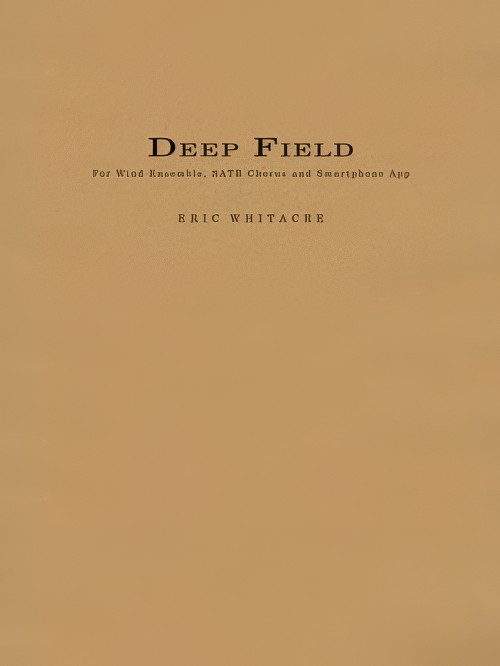 £499.99
£499.99Deep Field (SATB Chorus and Smartphone App with Concert Band - Score and Parts) - Whitacre, Eric
Score and Parts includes 40 choral octavos. Grammy Award-winning American composer Eric Whitacre's symphonic work Deep Field was inspired by the world's most famous space observatory, the Hubble Space Telescope, and its greatest discovery, the iconic Deep Field image. The new film - Deep Field: The Impossible Magnitude of Our Universe - illuminates the score by combining Hubble's stunning imagery, including never-seen-before galaxy fly-bys, with bespoke animations to create an immersive, unforgettable journey from planet Earth to the furthest edges of our universe. The soundtrack features a new, epic Virtual Choir representing 120 countries: over 8,000 voices aged 4 to 87, alongside the Royal Philharmonic Orchestra and Eric Whitacre Singers. The smartphone App playing the Deep Field electronica should be triggered by audience members from bar 217 to the end of the piece, as cued by the conductor. The app is free and must be downloaded in advance of the performance. It is available via the App Store and Google Play Store by searching "Deep Field." Duration: 20.00
Estimated dispatch 7-14 working days
-
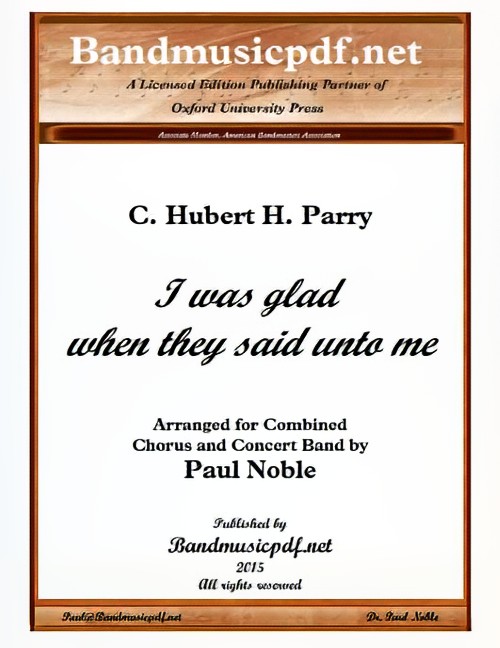 £110.00
£110.00I Was Glad When They Said Unto Me (Choir with Concert Band - Score and Parts) - Parry, Hubert C. - Noble, Paul
I Was Glad is an introit commonly used in the Anglican Church, and also used as an anthem traditionally sung at the coronation of the British monarch. Its most famous setting was written in 1902 by Sir Hubert Parry. Parry's version was composed for the coronation of King Edward VII in 1902, and revised in 1911 for that of King George V, when the familiar introduction was added. This setting employs antiphonal choir effects and brass fanfares. Apart from the imperial splendour of the music, the chief innovation is the incorporation in the central section of the acclamations Vivat Rex... or Vivat Regina... (Long live King/Queen...) with which the King's or Queen's Scholars of Westminster School have traditionally greeted the entrance of the monarch since the coronation of King James II in 1685. This section is generally omitted when the anthem is performed on other occasions. At the last coronation, that of Elizabeth II in 1953, the acclamation took the form of Vivat Regina Elizabetha. Parry's setting of I Was Glad was performed on 29 April 2011 at the Westminster Abbey wedding of Prince William, Duke of Cambridge and Catherine, Duchess of Cambridge (formerly Kate Middleton) as the processional music for the bride and her father and the bridal attendants. It had previously been performed at the wedding of the Duke's parents, Charles, Prince of Wales and Diana, Princess of Wales in 1981.
Estimated dispatch 7-14 working days
-
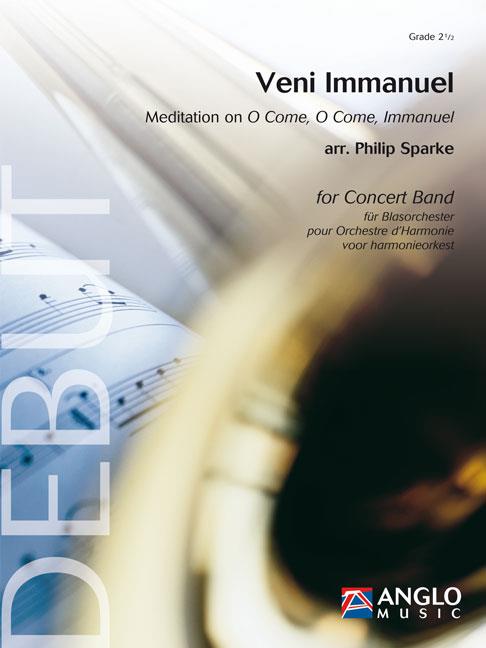 £99.99
£99.99Veni Immanuel (Concert Band - Score and Parts) - Sparke, Philip
Mediation on O Come, O Come ImmanuelThe Advent hymn we all know today as O Come, O Come, Immanuel was arranged in its modern form by Thomas Helmore and published in Hymnal Noted in 1856. Both the words and melody, however, predate this version by centuries.The tune, Veni Immanuel, is taken from a 15th century processional of French Franciscan nuns, part of the setting for the funeral hymn Libera Me. This arrangement aims to expand on the power and mystery of the original tune and will be most effective if the solo trumpet at the start and end of the piece can be placed away from the band, maybe at the back of the auditorium.Duration: 5:30
Estimated dispatch 7-14 working days
